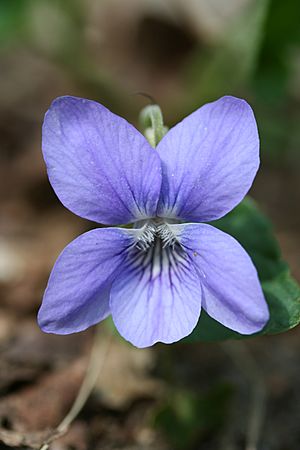Common dog-violet facts for kids
Quick facts for kids Common dog-violet |
|
|---|---|
 |
|
| Scientific classification | |
| Genus: |
Viola (plant)
|
| Species: |
riviniana
|
The Viola riviniana, often called the common dog-violet, is a beautiful flowering plant. You can find it growing across Europe, Asia, and Africa. People also call it the wood violet or just dog violet.
This plant loves to grow in places like the edges of woodlands, open grasslands, and shady areas near hedges. It can grow in almost any type of soil, as long as it's not too acidic or too wet.
The common dog-violet usually grows about 10 cm (4 in) tall. It can spread out to about 50 cm (20 in) wide. This plant is a perennial, which means it lives for more than two years. It has dark green leaves shaped like hearts. In May and June, it produces many lovely violet-colored flowers.
In 2002, the Viola riviniana was chosen as the county flower for Lincolnshire in the UK. This happened after a vote organized by a plant conservation group called Plantlife.
Contents
A Home for Butterflies
The common dog-violet is very important for many butterflies. It is a special food plant for the caterpillars of several types of fritillary butterflies. These include the pearl bordered fritillary, the small pearl-bordered fritillary, the silver-washed fritillary, and the high brown fritillary. The caterpillars eat the leaves of the violet to grow strong.
Meet the Relatives: Similar Violets
There are other violet plants that look a lot like the common dog-violet. Here are a few and how you can tell them apart:
Sweet Violet (Viola odorata)
The sweet violet has a lovely smell, unlike the common dog-violet. All its leaves grow from the very bottom of the plant.
Heath Dog-Violet (Viola canina)
This violet has clear blue flowers. Its leaves are narrower than the common dog-violet's.
Marsh Violet (Viola palustris)
You will find the marsh violet in wet places. Its leaves are shaped like kidneys. This plant grows from underground stems that creep along. Its flowers have dark veins.
Alpine Violet (Viola labradorica)
Sometimes, nurseries might sell V. riviniana by mistake as V. labradorica.
Plant Hybrids
The common dog-violet can sometimes mix with another plant called the early dog-violet (V. reichenbachiana). When they cross, they create a new plant called Viola × bavarica. This is an example of a plant hybrid.
See also
 In Spanish: Violeta de monte para niños
In Spanish: Violeta de monte para niños

